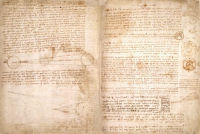Forces of Nature Click on the thumbnails to explore the trail
Read more about this trail (expand)
“Force”, the invisible agent of nature that provides all living things with motion, was a major obsession for Leonardo - the movement of turbulent water, curling hair and leaves that grow in swirling curves were all manifestations of the same natural force. In order to convey a sense of inherent energy in works of art and engineering, such phenomena must be fully understood

- Enlarge
- Zoom & explore
- Sheet 1B Fol 36v-36r - The flow of water through the eart and water on the moon © Seth Joel/CORBIS
Codex Leicester (formerly Codex Hammer) 1508-1512
Leonardo’s vision of the planet earth seems to be fairly straightforward. The “body” of the earth is contained within a sphere of water. This protrudes from the water in places because it is irregular and appears as landmasses and mountains, as shown in the upper diagrams on the right of this sheet. The spherical shape of the earth is maintained because all of the elements adopt a spherical shape around their own centre of gravity. However, things are not quite as simple as that!
The earth was not a solid mass. In the fifth drawing from the top, Leonardo illustrates the layered nature of the earth. It contains vast subterranean caverns formed by the erosive powers of water that flowed through the body of the earth.
These caverns continually collapse and fall in upon themselves. As they do, the heavy matter is pulled towards the centre of the earth and the light pushed towards the periphery, where it forms new mountains and landmasses. And so in the dynamic formation and reformation of the elements of the earth a perfect state of equilibrium is maintained.
In Leonardo's words
I consider that the highest mountain there is on the earth is as far above the surface of the sphere of water as the greatest depth of the sea is below the surface of the sea. It follows therefore that if one were to fill up the part wanting in the sea with the excess of earth, the earth would remain entirely spherical and covered by the sphere of water.
The Codex Leicester deals almost exclusively with science, water and hydraulics. There are also studies on the subjects of astronomy, cosmology, geology, with important notes regarding the composition and nature of the “body” of the earth.
This codex is now comprised of 18 loose double sheets, with densely compiled script in Leonardo’s characteristic mirror writing and over 300 small illustrations in the margins.
- Medium Pen and ink on paper
- Size 29 x 22 cm
- Location Private collection










